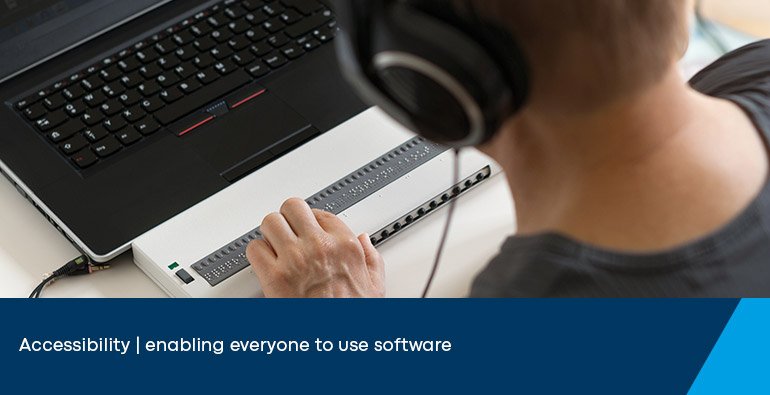Accessibility in software development

Software is playing an increasingly important role in all areas of life. Due to its growing importance, it is becoming more essential for everyone to be able to use software independently. Accessible software is the keyword here. This is already mandatory for public organizations, and from June 2025 the regulation will also be extended to online retail and various online services. This means that accessibility will also become mandatory for most private companies. However, developers and private companies can already benefit from it now.
What does accessibility mean in software development?
The idea of accessibility originates from the construction industry. There it was established that facilities must be accessible to everyone—in other words, barrier-free. Accessibility is defined in the Act on Equal Opportunities for People with Disabilities (Behindertengleichstellungsgesetz - BGG) § 4 Accessibility. According to this, something is barrier-free if it can be used, accessed, or found by people with disabilities without assistance or particular difficulty in the same way as it can be used, accessed, or found by able-bodied people.
Accessibility is more than just a friendly gesture, it is about self-determination and equal opportunities. Software must also be designed with this objective in mind.
Accessibility in the IT sector
Accessibility in the software context means increased user-friendliness. Companies should strive for this, not only for customer satisfaction, but also to reach a larger target group. Adding such functions retrospectively may seem costly, but it pays off over time. It is also foreseeable that accessibility will soon become mandatory for all software and websites.
Are there laws on software accessibility?
Digital accessibility laws have been around for some time. Reporting has grown in recent years as a result of updates and extensions. The Act on Equal Opportunities for People with Disabilities (Behindertengleichstellungsgesetz - BGG) has been in place since 2002. Accessible information technology is only a sub-item here. However, the Barrier-free Information Technology Ordinance (BITV) had to be implemented by December 31, 2005. The new version “BITV 2.0” came into force on May 25, 2019. It no longer describes the standards themselves, but refers to the harmonized standards of the European Union. An IT application must comply with this standard in order to meet the accessibility requirements.
However, accessibility is not yet mandatory for all software. It is only mandatory for federal and state public institutions. These include government offices, universities, hospitals, and libraries. The intranet of public authorities must also be fully accessible for employees.
The European Accessibility Act (EAA) came into force on June 28, 2019. This legal act defines common rules for software, digital services, and hardware that are sold or used in the EU. It therefore goes beyond state applications. From June 28, 2025, the legislation of the Accessibility Strengthening Act (BFSG) will apply. This obliges companies to comply with defined accessibility requirements for services (including online retail) that are provided to consumers. It therefore affects many manufacturers, retailers, importers and service providers.
Further standards and guidelines on software accessibility
The Web Content Accessibility Guidelines (WCAG 2.1) refer to the Internet. They apply internationally. There is also the specific PDF/UA standard (ISO 14289:1:2016-12), which covers the requirements for accessible PDF documents.
Some software companies, such as Microsoft, publish their own guidelines. In doing so, they pass on their expertise to external IT experts. At the same time, they provide information about the possibilities of their programs.
The Federal Monitoring Agency for Accessibility (BFIT-Bund) is an independent institution that checks the accessibility of public institutions. It also develops practical solutions and is therefore an important advisor.
What you should pay attention to—features for greater accessibility
There is currently no complete list of all possible functions. The BITV 2.0 only describes that the applications must be “perceptible, operable, comprehensible, and robust”. The specific requirements can be found in the EN 301 549 standard.
The following is a list of measures from the aforementioned standards, regulations, and guidelines that you should already integrate into your software:
- Text in simple language
Easy-to-understand formulations not only help people with cognitive impairments or non-native speakers. Simplification is particularly useful for every user when it comes to texts from public authorities or courts. It is important to adapt the language to the respective target group. - Screen reader
Read-aloud applications are available in acoustic and tactile versions, using a Braille display. Develop your software so that it can be read by machines. In the case of web applications, this also helps them to be found more easily by search engines. - Changeable font size, color and contrasts + screen magnifier
For better readability of the content, the font properties should be customizable, and the integration of a screen magnifier is particularly useful for visually impaired users. - Using symbols and colors
Color blindness, such as the widespread red-green weakness, makes it difficult to deal with texts and other website elements. Especially since certain colors are often used to differentiate elements from one another. Therefore, add symbols to the color markings so that, for example, positive and negative answers can be distinguished by everyone. - Alternative description for images
These texts describe in detail what can be seen in a picture. This not only helps blind people to understand your images. It also works if the graphic file is not displayed correctly and for SEO goals. - Subtitle
To ensure that hearing impaired and deaf people can understand software with audiovisual content, they need subtitles. These are also helpful in environments with loud background noises or when the loudspeaker is missing/deactivated. - Sign language
Explanations in sign language must already be available on the homepage of public institutions. Explanatory videos with sign language are not mandatory for privately distributed software, but they are a big step towards equal opportunities. - Talking links
To make links read out by a screen reader easy to understand, you should avoid using complex characters and numbers in your links. Instead, make them as simple, clear and descriptive as possible (avoid using the same or similar names). - Tabulator control
People with motor disabilities find it difficult to move the cursor accurately. Among other things, using the tab key makes it easier to fill in forms, even for people who prefer the keyboard to the mouse or use special aids (“assistive technologies”, e.g., joysticks). - Logical arrangement of elements
Changing, animated, or nested blocks may look interesting, but they make it difficult to read and use. Instead, use a tabular arrangement with a clear sequence. - Multiple contact options
If support needs to be contacted, some people find it easier to do so by phone, others by email. Therefore, make sure that you offer different communication channels. - Notes in case of incorrect entry
A function that everyone will be happy about: explanations of exactly what needs to be entered in which field and in which format. A message should also appear in case of an incorrect entry. - Voice commands/AIs
Artificial intelligence can already perform tasks on command. If this is also possible in your program, it will automatically become more accessible.
Conclusion
Just as minimum requirements are constantly evolving, software should always be up-to-date and comply with current standards. Even if accessibility is not yet mandatory for all software, it is advisable to integrate accessibility features into your own software now to enable unrestricted use. This allows you to reach a larger target group on the one hand and secure important competitive advantages on the other—accessibility is now required in many tenders.
The Web Gateway 2 offers various target group-specific customization options such as screen reader support, keyboard-only operation and the individual setting of font sizes, contrasts, and symbols. This ensures efficient, intuitive operation and barrier-free working in accordance with WCAG 2.1 standard, level AA.
Subscribe to our newsletter
Would you like to stay up to date on digital service management, GRC and automation? In our newsletter, we inform you about relevant blog posts and professional articles. We also regularly send you information about events, DACH-wide trade fairs and our free live sessions in the areas of service management, process automation, GRC and analytics with business intelligence. We will inform you about new features of the OMNITRACKER business process platform.
